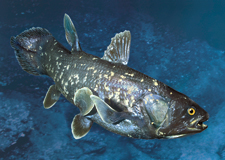Find “extinct” fish alive in South African waters
Read the full article (PDF) | Vote on future topic | Search archives
April 1, 1939 | Vol. 35 | No. 13
Find “extinct” fish alive in South African waters
Hint of a “Lost World” beneath the sea, a survivor of long-gone geologic ages, has been hauled up in a trawler’s net off the east coast of South Africa: a fish of a kind supposed to have disappeared utterly from the earth 50 million years ago.
Word received in Washington, D.C., was heard with amazement by scientists of the Smithsonian Institution, as if someone had announced the discovery of a living dinosaur. But the strange find is attested by the word of colleagues “down under” known to be competent and hard to fool. It seems impossible; yet apparently it’s real.
The fish is a rather big one, about five feet long, dark blue in color with a metallic luster, with big goggle eyes. It has two back fins, the forward one in two sections or lobes. The paired fins under its body are almost leg-like, paddle-shaped in outline. The two lobes of its tail-fin are uneven.
Closer inspection shows a pair of openings, known as spiracles, behind the eyes, sharp conical teeth like a cat’s, heavy bony plates under the wide jaw. The skeleton is made not of bone but of cartilage.
…
All this, to scientists, is a picture of an exceedingly primitive type fish. Some of the skeletal characters, and especially the bony jaw plates, mark the specimen as a surviving member of one of the most ancient groups of fishes, known as the Crossopterygians. There is no common name, for the whole family is supposed to have become extinct at least 50 million years ago, in Mesozoic time, the age of the dinosaurs.
UPDATE | December 3, 2011
Survivors lurk in Indian, Pacific
 Coelacanth fossils
were studied long before scientists got to know the living creatures.
Coelacanth fossils
were studied long before scientists got to know the living creatures.
When Marjorie Courtenay-Latimer first got a look at the strange sea creature that a trawling fleet had pulled from the waters off of South Africa’s coast in 1938, she immediately realized that it was something significant. Courtenay-Latimer, a curator at a natural history museum in East London, South Africa, sent a sketch to an amateur ichthyologist who later confirmed that the fish was indeed special — a coelacanth, a member of a group known only from fossil evidence and thought to be extinct for millions of years.
The name of the new species, Latimeria chalumnae, paid homage to its discoverer. But it was the amateur ichthyologist J.L.B. Smith who set out to find another coelacanth after the first had become putrefied and unsuitable for study. “He distributed illustrated leaflets up and down the east coast of Africa, printed in English, French and Portuguese. He cajoled trawler skippers to watch for the precious fish. He offered a handsome reward for its capture,” according to reports in Science News Letter. The efforts paid off, eventually: An intact, wholly preserved coelacanth was recovered from a native of the Comoro Islands, near Madagascar, in 1952.
Since this “living fossil” first appeared, around 300 specimens have been caught. In the late 1990s, coelacanths captured near Indonesia became a new species, named Latimeria menadoensis. And a report in November in the Proceedings of the National Academy of Sciences raises the possibility of a third family member, suggesting that a population of coelacanths living off of the northern portion of Tanzania’s coast may be distinct from their Comoro Islands relatives, having diverged 200,000 years ago. —Elizabeth Quill
Credit: ©Hoberman Collection/Corbis